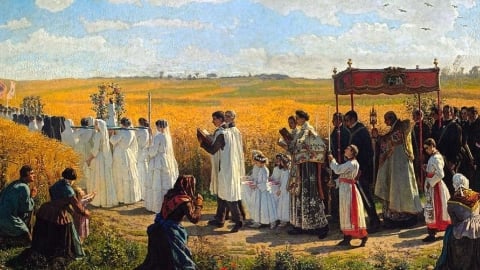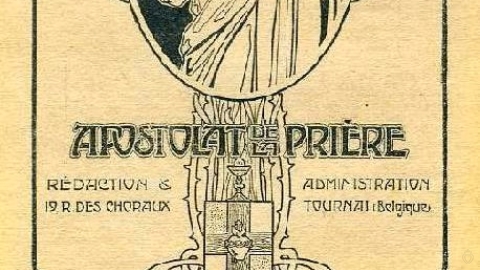Ignatian Year - Ignatian Mysticism

The fragments of St Ignatius's Spiritual Diary, providentially saved from destruction, are incomparably precious as a revelation of his mystical life. About this mystical life, three questions are of special interest.
1. Did God lead St Ignatius by the strictly contemplative way, i.e., the way of habitual infused contemplation?
Infused contemplation is characterized by three psychological facts: the sense of God's presence, passivity and simplicity. But for one to be in the way of habitual infused contemplation, it is not enough that his life of prayer be marked with passing touches of infused contemplation. Then only is a soul in the contemplative way, when it habitually lives under the influence of mystical grace; when infused contemplation becomes its usual form of prayer.
A glance at St Ignatius's confidences and Spiritual Diary leaves no room for doubt that he was led by the way of habitual infused contemplation. The daily 7 hours of prayer at Manresa, the gift of tears, the abundant consolations, the numerous intellectual and imaginative visions on the Blessed Trinity, on the mode of creation, the Eucharist, Our Lord's humanity (20 or 40 times at Manresa), Our Lady, all these are so many arguments in favour of, not transitory mystical graces, but a frequent and protracted illuminating action of God, which went increasing from Manresa on to the end of his life.
No one better than St Ignatius himself can bear witness to his ‘actuatio perpetua spiritus’ (Nadal). To Laynez he said, He had the grace of celestial consolation and visitation so ready to hand that he would say, if he wanted to find God supernaturally ten or more times a day, he could, by God's favour, do it easily.” And to Ribadeneira, “He could not live without consolation, that is, without perceiving in himself something which was not his, which could not even be his, but which came altogether from God' alone.”
As for “el tiempo de la distracion de los estudios” in Paris, it should be understood as a time when visions and other favours were rare; Ignatius himself had curbed them; and they should be carefully distinguished from his mystical life as such; the deeper undercurrent of direct affective contact with God was unaffected by the lessening of these favours.
2. What are the characteristic features of St Ignatius's contemplation?
First, with regard to its object, St Ignatius's contemplation is clearly Trinitarian' and Eucharistic. The Blessed Trinity is at the centre of his life. Our Lord, Our Lady, the Saints do not manifest themselves to Ignatius, except in connection with the Blessed Trinity, as intercessors and mediators. Numerous are the lights he received on the Blessed Trinity. He ‘senses’ and ‘sees’ the Persons, together or individually, their operations, processions and circumincession; at other times he only sees the Divine Essence without distinction of Persons.
St. Ignatius's mystical life is Eucharistic, not in the sense that he received a special abundance of lights on this mystery, but in the sense that all favours - Trinitarian graces included - are connected with the Eucharist: with the Mass and its various parts, from the preparation to the thanksgiving. And the graces received during the day appear as an extension or complement of the morning favours.
As for the nature of St Ignatius's mystical graces, the dominant feature, and we can call it the orientation of his mystical life, is “the dedicated love of a servant, the care to discern in its least nuances the desired service and to accomplish it, whatever it may cost, in a joyful élan of love, with a humble respect, a deep sense of the greatness and holiness of God, of the grievousness of the least failing: in a word, a mysticism of service and religion, steeped altogether in love”. The service of His Divine Majesty is the core of Ignatian mysticism. And it is striking to see how completely the gratuitous favours which were granted to our Founder agreed with the main lines of his asceticism, or more exactly, ... how faithful Ignatius's ascetical teaching was to the directions he received from God in his contemplation. His mysticism and asceticism alike are turned towards action. In his Diary as well as in the Exercises, we notice the same dominant care to find and embrace the will of God, (…) the same desire for a divine confirmation of the decisions he, has taken; we find the same devotion to the most Holy Trinity and the same deference for the Divine Majesty, the same sense of the infinite distance between God and us together with the most ardent effusions of love; we find that the same large share is given to the mediators, that the same subordinated but beneficent and useful role is played by the imagination and sensibility; in both Diary and Exercises we find an attentive and penetrating introspection, but no introversion that withdraws from daily life in order to be lost in the contemplation of God present in the soul.”
3. To what extent do these features look like or unlike the traditional scheme of mystical life as shown in the experiences of St Teresa and St John of the Cross?
Mystics are commonly divided by the theologians of mysticism into three classes: the seraphic, the cherubic and the angelic mystics. Seraphic souls are those whose will is mostly affected by God's action. The cherubic mystics are more directly influenced in their intellect. As for the angelic mystics, it is the memory, the imagination, the faculties of the concrete that are more particularly subjected to God's influence.
Because the intellectual or cherubic forms of infused contemplation are more easily discernible, it is according to these, theologians have built the classical schemes of contemplative life. Now St Ignatius is to be placed among the angelic mystics. It is therefore not surprising that a good many discrepancies will be found between Ignatian mysticism and the classical pattern of mysticism.
The first point to be noted is that for St Ignatius, service of God is not a consequence of mystical life, as it is for speculative mystics; it is its very object. There is no marked predominance in Ignatius's interior life, of either the graces of light or the graces of love; both of these are ordained towards action.
A remarkable feature —but not surprising in a mysticism that is oriented more towards service than union-- is the complete absence of the ‘nuptial aspect’ of the mystical union. No trace with Ignatius, of spiritual marriage or transforming union. Nor does one find in the Diary any mention of an ecstasy properly so called, that is, a suspension of the sense powers. Ignatian mysticism could be summed up as “a mysticism of loving service of God after Christ's example.”
Purity of Heart through frequent Communion: “…Among the many and great graces which a soul obtains by receiving her Creator and Lord, there is first and foremost that she is not left for long, nor deeply encumbered, in sin, even in very light sins, though no sin should be called light, since they all offend the sovereign, infinite Goodness. For when such a soul falls, He immediately makes her rise up, with greater strength and a firmer resolve to serve her Creator and Lord...” To Fr. Borgia, end of 1545 (Monumenta Ignatiana I, 341, in MHSI)
(Condensed from Joseph de Guibert, “Mystique Ignatienne - A propos du 'Journal Spirituel' de Saint Ignace de Loyola,” Revue d' Ascetique et de Mystique, XIX (1938), pp. 3-22 and 113-140)





